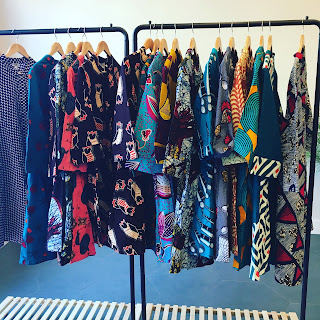Fashion: Made in Africa - Zuri's "One Dress"
 |
| Zuri dresses in San Francisco |
Two partners had a hit on their hands when they designed and produced one simple dress, in a variety of African print fabrics: Zuri. The company has been featured in the New York Times and the San Francisco Chronicle, among other publications.
Zuri has a brick and mortar shop in New York City, but San Francisco residents got a first taste at the pop up shop, in October 2017.
The dresses' reputation caught the attention of Eden Stein, owner of Secession Art and Design. Usually only local designers are featured, but her customers were clamoring for the dresses.
 |
| A Zuri dress in the Secession store window |
In her words: "I was at a gala for Artspan, mingling with 800 emerging and established artists, when I saw artist Soad A. Kader in her Zuri dress. I beelined to give her a compliment. She told me about a pop up they were doing that weekend in SF. I went and instantly connected with the designers. This wearable art gem is the perfect dress buttoned or easy as a coat over a more casual look. One dress that fits so many women is helping create a sustainable economy in Kenya for the Zuri production team. I feel honored to be their first store in San Francisco. This is a great way to connect our local design community with what is happening globally."
The dresses initial conception was through Sandra Zhao, who needed to travel in Africa with clothing that would be comfortable, stylish, yet easy to pack.
She later met Ashleigh Miller, who was taken with the concept of comfort + style (she was pregnant at the time), and they partnered to create the business.
A short interview with Sandra and Ashleigh:
 |
| The partners: Sandra Zhao and Ashleigh Miller in San Francisco |
We select our fabrics based on a couple of factors: 1) quality of the material (we try to select material that we know to be colorfast, 100% cotton, and preferably unwaxed finish for a more natural swing when worn); 2) design: we pick what we love! We try and pay attention to seasonality in the United States, but in general, we just pick the prints we like. There are SO many to choose from; it's a serious exercise in filtering, but luckily we have the same taste, so we agree on pretty much everything. Additionally, if a customer writes to us, and says there is a color or print they'd love to see, we always keep my eyes open to make sure we get it for them (for everyone who writes, we assume there are others who feel the same way).
- How do you handle production with local tailors?
We have worked with a couple different ethical manufacturing partners who do our bulk production here in Kenya. They're amazing! We are really proud of the impact they have on the local communities, as well as (of course) the quality of their work. We also work with a tailor here in Nairobi who has been our rock through this whole process. She got us started and helped us push through our first flood of orders; she's been our advisor, our champion (and sometimes, our psychologist...). We still work with her team to do our prototypes for new products before having the digital pattern made.
 |
| Zuri dresses production at Soko |
We are currently working with 32 tailors and cutters to produce our dresses. Additionally, we buy huge amounts of fabric every 3 weeks from about 20 independent kitenge dealers in Tanzania. We have a couple of point people there who source for us between trips, and then of course the baskets, shukas, our motorbike ("boda boda") team for local deliveries, etc. I'd say we probably fully support 40 people, and Zuri is a major part of the monthly income for another 20 people.
Notes:
- Zuri opened a San Francisco store on Fillmore Street in September, for at least 4 months.
- Secession Art & Design hosted a pop-up for clothing designers Zuri on Friday, March 30, 4-8pm. Designers Ashleigh and Sandra had recently spent time in Africa, choosing new fabrics for spring and meeting with their makers. They told the stories behind what it's like to work globally and create a fair-trade "one dress" that looks good on so many women. #JustOneDress
 |
| Fabric shopping - Kariakoo market, Dar es Salaam, TZ |
A previous Away From Africa blog post about fashion and clothing in Africa: http://www.awayfromafrica.com/2010/08/traditional-and-contemporary-dress-from.html





Comments
Post a Comment
Please let me know your thoughts and questions. Also, if you feel that anything is incorrect, please let me know.
I need to moderate the comments, as in recent years there has been a spike in spam.